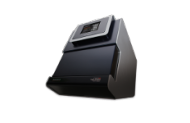MicroScale Thermophoresis
MicroScale Thermophoresis (MST) is based on the directed movement of molecules in a temperature gradient which strongly depends on a variety of molecular properties such as size, charge, hydratation shell or conformation thus being a powerfull technique to quantify biomolecular interactions.
Application examples:
- Protein folding
- Thermodynamics
- Interactions in complex liquids
-
KD determination
-
Ultra-high affinity measurements
-
Enzyme kinetics
We operate with the Nano Temper technologies Monolith NT.115 (BLUE/RED) that measures biomolecular interactions via detection of fluorescent dyes or fluorescent fusion proteins, providing a broad application range to detect interactions between any type of biomolecules and for pM to mM binding affinities. The MO.Affinity Analysis software allows for a straightforward analysis and evaluation of the MicroScale Thermophoresis data. Binding parameters such as dissociation constants (Kd) or EC50 values and can be easily quantified and compared.

Latest publications with our Monolith NT.115
Trovão, F. et al. The structure of a Bacteroides thetaiotaomicron carbohydrate-binding module provides new insight into the recognition of complex pectic polysaccharides by the human microbiome. J. Struct. Biol. X 7, (2023).
https://doi.org/10.1016/j.yjsbx.2022.100084
Brás, N. F. et al. Combined in silico and in vitro studies to identify novel antidiabetic flavonoids targeting glycogen phosphorylase. Bioorg. Chem. 108, (2021).
https://doi.org/10.1016/j.bioorg.2020.104552
López-Méndez, B. et al. Reproducibility and accuracy of microscale thermophoresis in the NanoTemper Monolith: a multi laboratory benchmark study. Eur. Biophys. J. 50, 411-427 (2021).
https://doi.org/10.1007/s00249-021-01529-1
Correia, V. G. et al. Mapping Molecular Recognition of β1,3-1,4-Glucans by a Surface Glycan-Binding Protein from the Human Gut Symbiont Bacteroides ovatus. Microbiol. Spectr. 9, 1-18 (2021).
https://doi.org/10.1128/Spectrum.01826-21
MicroScale Thermophoresis
MicroScale Thermophoresis (MST) is based on the directed movement of molecules in a temperature gradient which strongly depends on a variety of molecular properties such as size, charge, hydratation shell or conformation thus being a powerfull technique to quantify biomolecular interactions.
Application examples:
- Protein folding
- Thermodynamics
- Interactions in complex liquids
-
KD determination
-
Ultra-high affinity measurements
-
Enzyme kinetics
We operate with the Nano Temper technologies Monolith NT.115 (BLUE/RED) that measures biomolecular interactions via detection of fluorescent dyes or fluorescent fusion proteins, providing a broad application range to detect interactions between any type of biomolecules and for pM to mM binding affinities. The MO.Affinity Analysis software allows for a straightforward analysis and evaluation of the MicroScale Thermophoresis data. Binding parameters such as dissociation constants (Kd) or EC50 values and can be easily quantified and compared.

Latest publications with our Monolith NT.115
Trovão, F. et al. The structure of a Bacteroides thetaiotaomicron carbohydrate-binding module provides new insight into the recognition of complex pectic polysaccharides by the human microbiome. J. Struct. Biol. X 7, (2023).
https://doi.org/10.1016/j.yjsbx.2022.100084
Brás, N. F. et al. Combined in silico and in vitro studies to identify novel antidiabetic flavonoids targeting glycogen phosphorylase. Bioorg. Chem. 108, (2021).
https://doi.org/10.1016/j.bioorg.2020.104552
López-Méndez, B. et al. Reproducibility and accuracy of microscale thermophoresis in the NanoTemper Monolith: a multi laboratory benchmark study. Eur. Biophys. J. 50, 411-427 (2021).
https://doi.org/10.1007/s00249-021-01529-1
Correia, V. G. et al. Mapping Molecular Recognition of β1,3-1,4-Glucans by a Surface Glycan-Binding Protein from the Human Gut Symbiont Bacteroides ovatus. Microbiol. Spectr. 9, 1-18 (2021).
https://doi.org/10.1128/Spectrum.01826-21
